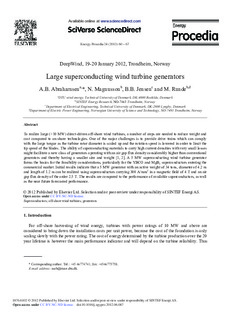| dc.contributor.author | Abrahamsen, A.B. | |
| dc.contributor.author | Magnusson, Niklas | |
| dc.contributor.author | Jensen, B.B. | |
| dc.contributor.author | Runde, Magne | |
| dc.date.accessioned | 2017-12-20T14:37:47Z | |
| dc.date.available | 2017-12-20T14:37:47Z | |
| dc.date.created | 2012-08-15T14:33:34Z | |
| dc.date.issued | 2012 | |
| dc.identifier.citation | Energy Procedia. 2012, 24 60-67. | nb_NO |
| dc.identifier.issn | 1876-6102 | |
| dc.identifier.uri | http://hdl.handle.net/11250/2473352 | |
| dc.description.abstract | To realize large (>10 MW) direct-driven off-shore wind turbines, a number of steps are needed to reduce weight and cost compared to on-shore technologies. One of the major challenges is to provide drive trains which can comply with the large torque as the turbine rotor diameter is scaled up and the rotation speed is lowered in order to limit the tip speed of the blades. The ability of superconducting materials to carry high current densities with very small losses might facilitate a new class of generators operating with an air gap flux density considerably higher than conventional generators and thereby having a smaller size and weight [1,2]. A 5 MW superconducting wind turbine generator forms the basics for the feasibility considerations, particularly for the YBCO and MgB2 superconductors entering the commercial market. Initial results indicate that a 5 MW generator with an active weight of 34 tons, diameter of 4.2 m and length of 1.2 m can be realized using superconductors carrying 300 A/mm2 in a magnetic field of 4 T and an air gap flux density of the order 2.5 T. The results are compared to the performance of available superconductors, as well as the near future forecasted performance. Copyright © 2012 Published by Elsevier Ltd. | nb_NO |
| dc.language.iso | eng | nb_NO |
| dc.publisher | Elsevier | nb_NO |
| dc.rights | Attribution-NonCommercial-NoDerivatives 4.0 Internasjonal | * |
| dc.rights.uri | http://creativecommons.org/licenses/by-nc-nd/4.0/deed.no | * |
| dc.title | Large Superconducting Wind Turbine Generators | nb_NO |
| dc.type | Journal article | nb_NO |
| dc.type | Peer reviewed | nb_NO |
| dc.description.version | publishedVersion | nb_NO |
| dc.source.pagenumber | 60-67 | nb_NO |
| dc.source.volume | 24 | nb_NO |
| dc.source.journal | Energy Procedia | nb_NO |
| dc.identifier.doi | 10.1016/j.egypro.2012.06.087 | |
| dc.identifier.cristin | 938851 | |
| dc.relation.project | Norges forskningsråd: 193823 | nb_NO |
| dc.description.localcode | © 2012 Published by Elsevier Ltd. Selection and/or peer-review under responsibility of SINTEF Energi AS.Open access under CC BY-NC-ND license.Open access under CC BY-NC-ND license. | nb_NO |
| cristin.unitcode | 194,63,20,0 | |
| cristin.unitname | Institutt for elkraftteknikk | |
| cristin.ispublished | true | |
| cristin.fulltext | original | |
| cristin.qualitycode | 1 | |

